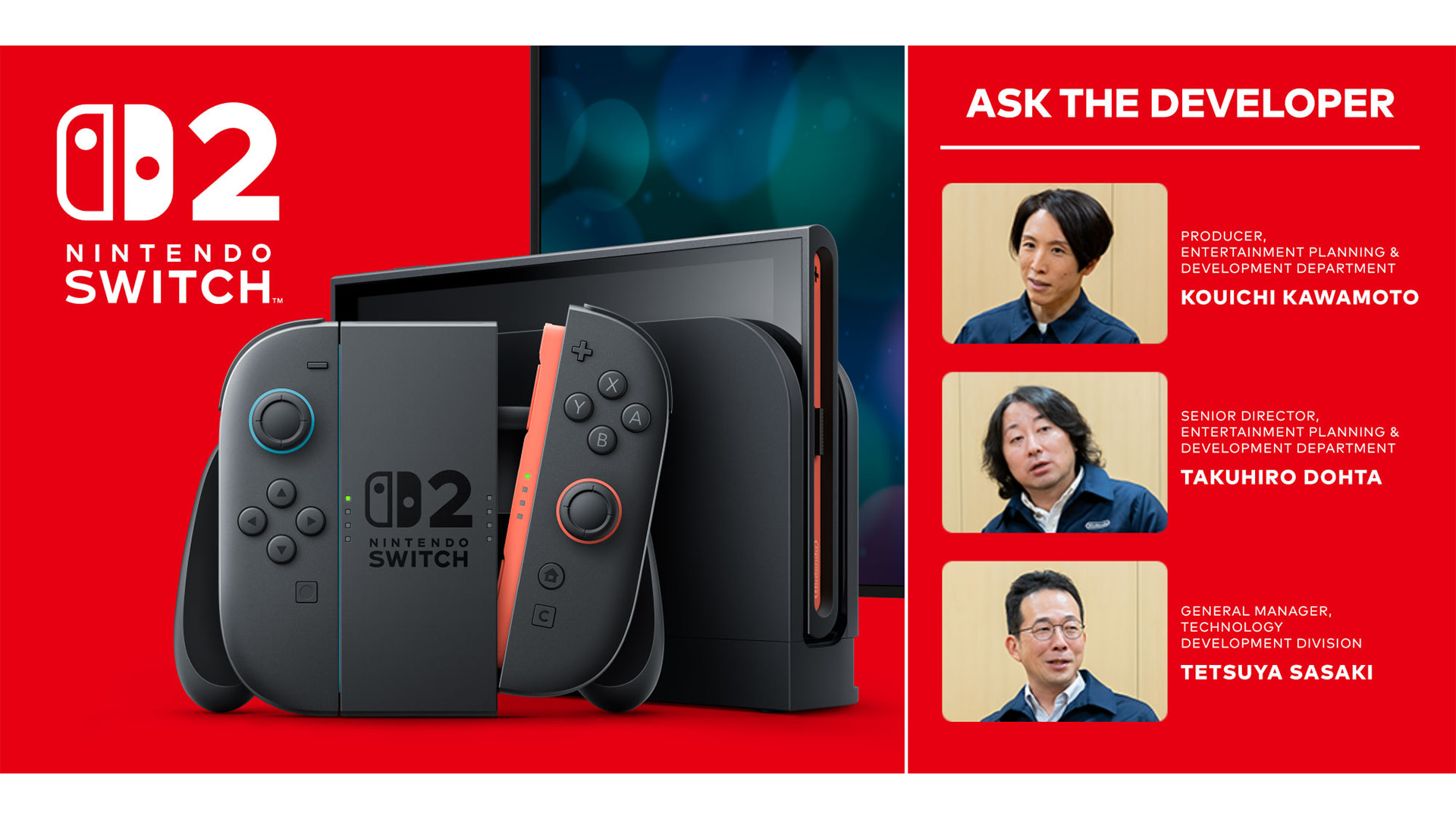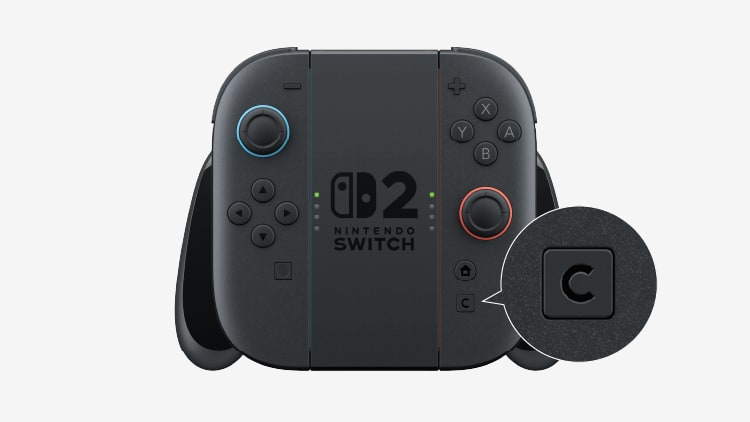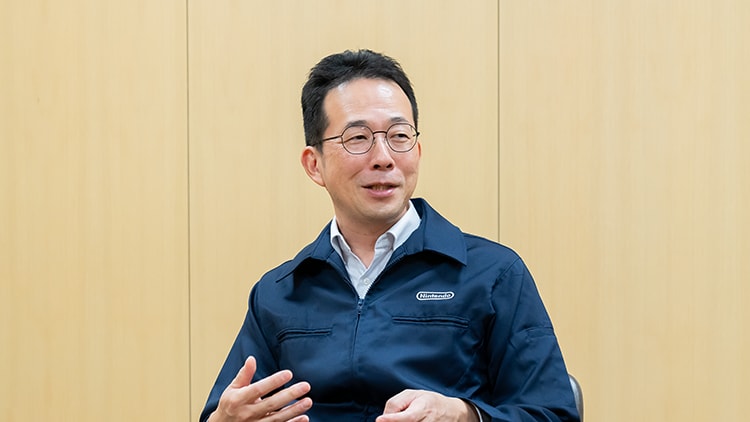
Ask the Developer Vol. 16: Nintendo Switch 2 — Part 3
This article has been translated from the original Japanese content.
This interview was conducted before the system was released.
In this 16th volume of Ask the Developer, an interview series in which developers convey in their own words Nintendo's thoughts about creating products and the unusual details they hone in on, we're talking to the developers behind Nintendo Switch™ 2, which launches on Thursday, June 5.
Check out the rest of the interview
Part 3: Inherently added value
When talking about how the Joy-Con 2 and Nintendo Switch 2 Pro Controller have been updated, so far, we've discussed changes that aren't obvious at first glance. However, there are some more noticeable updates. I’m curious about the newly added C Button on the controller. What does it do?
Kawamoto: This is the button you press to use GameChat (18), one of the Nintendo Switch 2 system's new features. Nintendo Switch supports voice chat via the Nintendo Switch Online smartphone app (19), but we originally wanted to include it as a feature of the system itself. However, with the Switch system’s processing capability, it was difficult to implement a voice chat feature without affecting games, so we decided to offer it via a smart device. With Switch 2, we were able to include it as a standard feature of the device. I’m sure many of you have had experiences of playing games together as children at a friend’s house or in a student lounge, where everyone brought their own consoles, and we wanted to recreate that feeling online. Sometimes you'd all play the same game together, but there were also times when everyone gathered together even though they were each playing their own game.
(18) GameChat requires an internet connection and a Nintendo Account with a Nintendo Switch Online membership. For other terms and conditions of use, please see here.
(19) The name of the app will be updated in the future to the Nintendo Switch App.

Yes, I remember it being quite common to see children gathering in the park to play Pokémon on Game Boy.
Kawamoto: This time, you can chat with others and play the same or different games using the console's features. There's also a new feature that's been added to the console, which was born from our experience developing software remotely for a time due to COVID-19. Back then, we were using a video conferencing system to check the software we were developing with our team, but the screen-sharing function built into the video conferencing system only allowed us to share one gameplay screen at a time. So, we had each person place their game screen in front of their camera instead of their faces. When we did that, it felt like we were all in the same place, each bringing our own console to play the game together, which was a lot of fun. Based on this experience, we proposed adding a feature to Switch 2 where people can share their gameplay screen with other players.
Sasaki: Of course, game developers will want to take full advantage of the device's capabilities in their games, so we want to minimize the resources used by the console's system software. Nevertheless, we decided to try implementing game screen-sharing because we thought it was an important feature for this hardware that would add immense value, and is only possible due to the expanded processing capability.
When the software developers heard about the new chat feature, did you see potential in it?
Dohta: We felt that having this new chat function implemented directly into the hardware could offer something new to players without any additional effort from the software developers. We also thought it might lead to the discovery of a completely different way to play games. For example, The Legend of Zelda: Breath of the Wild was originally developed for the Wii U home console, but by making it available on Switch, we created the value of “being able to play anywhere.” It might be taken for granted these days, but when a game that could only be played on a TV suddenly became playable anywhere, it felt like the software experience reached a new level, even though we, as software developers, hadn't added anything. Being able to play in both TV mode and handheld mode may seem like a normal thing now, but back then, I thought it was amazing.
Similarly, GameChat, a new feature for this console, inherently adds value and is automatically available for all games that are compatible with Switch 2. Of course, you can use it to play online with friends, but even with single-player games, you can share your screen with others and get them to help you come up with strategies, or give you tips when you're stuck. Or, if you see your friend playing a game that you aren't familiar with, it may spark your interest in that game, and you can ask them about it.
That way, whenever a game is released for Switch 2, value is added automatically without the software developers having to put in a special effort. I think it would be fair to say this feature represents a true progression from Nintendo Switch, which added the value of enjoying a home console gaming experience on the go, and will be something unique to the successor. For this reason, we felt it was worth implementing it in Switch 2.
Sasaki: We also think it’s essential to have a feature that software developers can benefit from without any additional effort. As video conferencing has become more common throughout the world in the wake of the COVID-19 pandemic, there are now more diverse demands and expectations for video call systems. However, when deciding on GameChat's features and which of those demands we could meet, we had to be careful, as devoting too much processing power to GameChat would affect how much is left over for games. Fortunately—or unfortunately—we had a group of fussy software developers who were very vocal with us, so we were able to strike a good balance. I think our company has a workplace culture where developers can devote themselves to creating uniquely Nintendo products because they don't hold back when sharing their opinions with us. (Laughs)
Dohta: The software and system developers started discussing how much processing power should be spent on the software versus the system—almost like a budget negotiation. (Laughs)
Sasaki: You're right! (Laughs) The software developers would say, “We want all these features, but with a system resource budget of zero.” And the system developers would come back with, “I'm afraid we can't work within that budget.” (Laughs)
So, there was a tug-of-war between the software developers and the system developers, each trying to achieve their vision.
Dohta: But as we tried out prototypes and communicated with each other, we started to get a feel for how much processing capability and memory was needed for a particular level of functionality and where we should allocate more budget. Through such repeated efforts, we were able to reach a common understanding of which features were worth including based on how much of the system's processing power they would use.
After these tug-of-war negotiations, did you reach the outcome you were hoping for, Kawamoto-san?
Kawamoto: Various professionals went through trial and error to achieve the best outcome, and I think it turned out much better than the original proposal I came up with. If you connect the Nintendo Switch 2 camera, a Switch 2 accessory that's sold separately, your face will appear on your game screen. What I found interesting was that this makes you feel a bit like a livestreamer. This kind of pleasant moment was not something we anticipated in the early stages of development.
Feeling like a livestreamer sounds fun. But whether you're streaming or just chatting with others, it seems like a microphone would play an important role.
Kawamto: Yes, there were so many twists and turns, especially when deciding where to place the microphone—should we have it in the Joy-Con 2 controllers or the console? We considered how people would place the dock and the position of the cooling fan, and we ultimately decided to build it into the top of the console.

The device also contains a high-performance audio processing chip that can eliminate unwanted noises.
This means that the sound of pressing buttons or the console's cooling fan won’t be heard by those you're speaking to through the microphone.
Dohta: You can hardly hear the noise of a vacuum cleaner.
Wow!
Kawamoto: Even if your parents are vacuuming next to you while you're playing a game at home, those you're chatting with will barely be able to hear it. The first time I tried listening out for the sound on voice chat, I was pretty surprised. I thought to myself, “What? Was there even a vacuum on?”
Sasaki: The software developers' requests regarding this noise-canceling feature were also interesting.
They wanted the vacuum cleaner's noise to be minimized, but they didn't want the players' excitement, such as applause and cheers, to be canceled out. Deciding which sounds to let through and which not to, and the development needed to achieve this selective noise-cancellation feature, was extremely challenging. There was a whole stack of other requests too... (Laughs)
Everyone: (Laughs)
Kawamoto: Of course, it’s important that people can hear what you say, but it’s also crucial that the emotions, or rather the lively atmosphere, is conveyed to others too... So, we ended up asking the impossible.
Sasaki: Not at all, I thought it was an interesting idea.
Kawamoto: On top of that, the noise-canceling chip in Switch 2 has a feature called “automatic gain control” that automatically adjusts the volume. So whether you’re playing in handheld mode, where you’re close to the console, or in TV mode, where you’re further away, the volume of your voice will be adjusted to the appropriate level. This feature makes it possible to enjoy GameChat in many different environments.
Will it work if more than one person speaks into the same microphone?
Kawamoto: Multiple people can speak into the same microphone. It recognizes differences in the volume of each person’s voice and automatically adjusts all voices to the same volume.
Since GameChat is a major feature of Switch 2, I look forward to having the opportunity to interview the other developers who were deeply involved with it. Speaking of features that bring excitement to multiple players, one of the major features of Switch was sharing Joy-Con controllers (20) with others. How has this feature changed in the new console?
(20) A feature in which players can share one of their Joy-Con controllers with others and play the same game together.
Kawamoto: Just like Switch, you can share Joy-Con 2 with others on Switch 2 as well. But even when we were developing Switch, we wanted to implement a feature to share gameplay with other systems in addition to sharing Joy-Con. In the past, Game Boy Advance and Nintendo DS had a feature called Download Play, where you could send a portion of a game to friends and play together. We looked into the possibility of having this feature on Switch as well. But the data volume of Switch games is so large that it takes a very long time to transfer data, so we had to abandon this idea.
Having to wait tens of minutes to play a game together isn't very practical.
Kawamoto: So, we thought that by taking advantage of the Switch 2 system's processing power and using the same streaming technology that Wii U uses to send images from the console to the handheld Wii U GamePad (21), we could share the gameplay instantly without having to take time to transfer the software. I thought it’d be nice if players could share games instantly and play together competitively or cooperatively. This was another feature I asked Sasaki-san to look into. Achieving it must have been a nightmare. (Laughs)
(21) A controller unique to Wii U equipped with a touch screen in addition to control sticks and buttons. Images from the game running on the Wii U console are transferred to the GamePad and displayed on its screen.
Sasaki: Nah, I figured something like this might happen...
Everyone: (Laughs)
Was this something you were already looking into before you received the request?
Sasaki: Indeed. Those of us in the Technology Development Department want to be able to say, “We thought you'd need something like this,” when a new request comes in, so we're always researching and developing all kinds of things in advance. (Laughs) Such a wireless streaming feature that enables players to share their games via streaming is something we've been researching for a long time. We realized we could achieve this by taking advantage of the latest technology in wireless streaming communications, which in turn allowed us to come up with a new way of sharing games.

Dohta: With this new feature, which we call GameShare, you can share selected parts of supported games with up to three people. In other words, up to four people can now play together using just one copy of the game. Using GameShare to play with others locally works just like Download Play, which was available on some of our previous consoles, but what separates it is that you can start playing right away.
GameShare is a feature that's only available on Switch 2, right?
Dohta: Well, what's interesting about that is, when using GameShare locally, some games can be shared to both multiple Switch 2 and Switch consoles.
So, does that mean that with GameShare, Switch 2 and Switch owners can experience Switch 2 games together locally?
Dohta: Exactly. Even if you decide to purchase Switch 2, your old Nintendo Switch could still come in handy. In addition, you can share games online using GameChat. If one person has the game, up to four people can play it together while using voice chat. GameChat is a feature that's exclusive to Switch 2, so online game sharing will only be available among Switch 2 consoles.
From what I’ve heard so far, it sounds like you achieved a lot of things fairly smoothly, but was that really the case?
Sasaki: Smoothly...would be a gross exaggeration. (Laughs) There's always a gap between research and turning it into a product. It's not enough to be confident that a certain technology has potential and could be used in a product. We then need to proceed with development while keeping in mind what kind of experience we want to offer with that technology.
Kawamoto: It wasn’t an easy thing to do. The quality of the game image is reduced when it's transferred using streaming technology, so the team tried to find a way to maintain the quality as much as possible through trial and error. Also, with GameShare, there are games where it’s better if players aren’t shown the same screen, so we’ve created a feature that enables each person to see a different screen even if they're playing together with just one copy of the game. For example, when playing card games and mahjong in Clubhouse Games: 51 Worldwide Classics, each player is shown a different screen because it wouldn't work if everyone was shown the same screen. So, with GameShare, you can play cards or mahjong with players locally or those connected online via GameChat right away.
Will GameShare only be available in certain games?
Dohta: That's right. GameChat is an exclusive feature for Nintendo Switch 2 and is compatible with all games, but GameShare can only be used with compatible games that have a special program built in.
Kawamoto: GameShare may not be suitable for certain games due to things like responsiveness.
For example, it may not be ideal for games that require precise timing of button inputs, such as rhythm games. As for Nintendo games, we'll choose ones that best fit the feature.
I see. From what you've told me, I get the impression that the infinite receptiveness of Sasaki-san’s team, who are ahead of the curve in a lot of things, is legendary.
Everyone: (Laughs)
Sasaki: It’s all thanks to the extensive daily research of everyone on the team.
Read more in Part 4: A new standard
Additional games, systems and/or accessories may be required for multiplayer mode. Internet, Nintendo Switch Online membership and Nintendo Account required for online features, including GameChat. Nintendo Switch 2 camera required for video features. Not available in all countries. Terms and GameChat requirements apply. support.nintendo.com Games, systems, some accessories, membership and the Nintendo Switch 2 camera sold separately.
